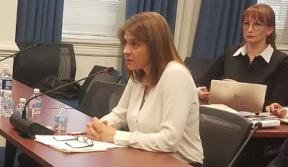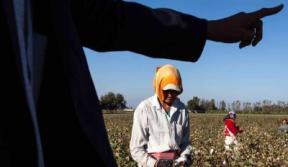After marching, representatives from several of the groups participating in the demonstration gave speeches. ILRF’s Executive Director Bama Athreya, George Washington University student Amanda Formica affiliated with United Students for Fair Trade, Stan Gacek of the AFL-CIO, Sally Greenburg of the National Consumers League
Antonia Cortese, Secretary-Treasurer of the American Federation of Teachers, said “For more than two million Uzbek students, going ‘back to school’ also means going ‘back to the fields’, as they and their teachers are forced to leave school to perform long, hard and dangerous work in the country’s cotton fields. While the government and the bosses reap the profits, the children lose valuable time while toiling in the fields for little more than meager meals.”
Jim Winkler, General Secretary of the General Board of Church and Society for the United Methodist Church also spoke of the connection between consumption and morality: “People of all faiths in the U.S. and around the world want to be sure that the clothing they buy is made by workers who enjoy ethical working conditions.”
As these speakers indicate, children in Uzbekistan are forced by their own government to pick cotton at the beginning of the school year. Every year, up to two million children and teachers become forced labor in Uzbekistan’s cotton fields. This cotton enters the global cotton market and earns the government over a billion dollars a year, very little if any of this money ever makes its way to the workers themselves.
Uzbekistan is the world’s second largest exporter of cotton and up to one third of the country’s workforce labors on cotton farms. While the cotton industry is very profitable for a few large landowners and political elites, the vast majority of cotton farmers live in dire poverty. Independent union representation is almost nonexistent for workers. Thousands of children as young as seven are forced, by government decree, to work in the cotton fields instead of attending school in order to meet government-imposed cotton production quotas. Even children who are enrolled in rural schools are often dispatched to work in the fields when their schools are closed down during harvest time by government officials. Some children are conscripted to work in remote areas where they are forced to stay in dormitories while they pick cotton.
The cotton from Uzbekistan travels to places like Bangladesh and China where it is turned into fabric for clothing, bedsheets and other products for the US consumer market. ILRF has been active on this issue for over two years and we are prepared to put even more pressure on the government of Uzbekistan to stop this unacceptable practice of forced and child labor in its cotton fields. International brands and retailers including Walmart, Target, Levi Strauss, GAP, Limited Brands, Disney and Nike, among many others, have agreed to ban Uzbek cotton from their supply chains until forced child labor is ended.
THE TIME IS NOW TO END THE EXPLOITATION OF CHILDREN AND TEACHERS IN UZBEKISTAN'S COTTON FIELDS.


Comments
re: Demonstrating against Child Labor in Uzbekistan’s Cotton Fie
It is easy to boycott uzbek cotton for us but after that result will be more forced child labor will be turn to another occupation for financial crisis. It will be better for us to avoid us types of activities they need motivation. And we should first give them knowledge to avoid child labor in cotton field no only even all placeses of Uzbek. We may inform to uzbek government and in uzbek NGO to motivate the farmers and landwoners. We know when harvast comming all the family members angage in the field even also first world. But forced child labor is not accepable for us and we should protect by hard also.